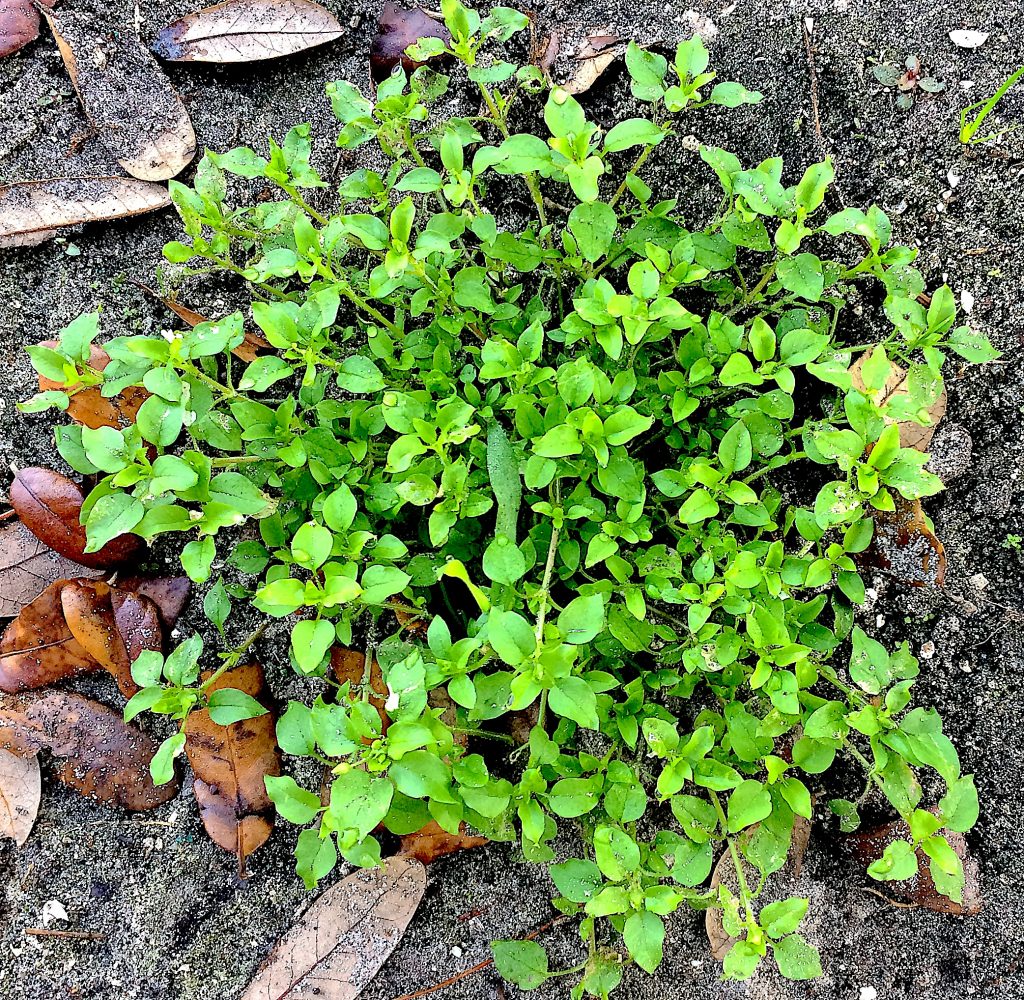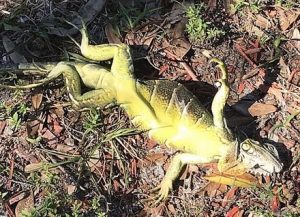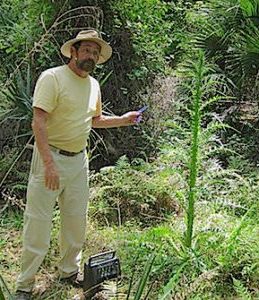
Chickweed Thrives in Cooler Weather. Photo by Green Deane
It’s the time of year for chickweed and falling iguanas. In northern climates chickweed germinates under the snow so when the snow melts the chickweed is ready to go. Locally it rarely snows but the chickweed waits for our coolest weather to sprout. It can be found now as far south as Tampa. Cold-blooded Iguanas, like birds, roost in trees and when the nights get cold they lose their grip and drop. I’ve seen them fall out of trees while I was giving a class nearby.
There are about five species of chickweed in the Stellaria genus, all are edible, though one, mouse-ear chickweed, is usually cooked, the others eaten raw or cooked. Our most abundant species, Stellaria media, mildly tastes like raw corn. It can be used a variety of ways, soup to pesto. Cooked it is similar to young spinach, dried it can be powered and used to make bread or thicken soups.

Chilled Green Iguana. Photo by Maxine Bentzel
Iguana is a delicate crab-like meat and readily takes up flavors. Each iguana offers six pieces, four legs, a tail and the back strap. Many years ago there was an inexpensive Florida iguana cook book, costing just a few dollars. Now it sells for $100. The author, George Cera, was well-known for removing 16,000 iguanas from Boca Grande Florida. Iguana graces my dinner plate now and then, usually in the winter. A news report from January 2020 detailed how a man put several cold-stunned iguanas in his car to take home for consumption, but they warmed up in his car nearly causing an accident.
If the chickweed you picked has white sap you have made a mistake and have harvested Euphorbia pelpus (radium weed) which is not edible but is excellent in treating skin cancer topically. Chickweed has a white elastic core, and a single line of hair along the stem. To read more about chickweed, go here.

Foraging classes are held rain, shine, hot or cold. Photo by Nermina Krenata
Foraging classes: Erratic weather is still plaguing us. Chilly this weekend and probably colder the week after.
Jan 4th: Spruce Creek Park, 6250 Ridgewood Ave. Port Orange, 32127. 9 a.m. to noon. Meet at the Pavilion.
Jan 11th, Dreher Park, 1200 Southern Blvd., West Palm Beach, 33405. Take exit 68 (Southern Boulevard) off Interstate 95 and go east. Entrance to the park is an immediate right at the bottom of the interstate bridge. Follow the convoluted signs to the science center (which is not where the GPS puts you.) Park anywhere. We meet 300 feet northwest of the science museum near the banyan trees. 9 a.m. to noon.
For classes bring cash on the day of class or click here to pay for your class.

Redflowered Ragweed. Photo by Green Deane
Redlfower Ragweed isn’t a ragweed but I’ve been seeing it for a few years now. It reminds me of Fireweed/Burnweed except with red blossoms and much larger. Botanically it’s Crassocephalum crepidioides (kras-oh-SEF-uh-lum krep-pid-dee-OY-deez.) Crassocephalum is from the Dead Latin “Crassus” meaning “thick” and “kephale” which is Greek for head. Crepidioides is more mangle Greek. “-oides” in Dead Latin is mispronounced borrowed Greek and means “resembles.” Crepidioides means “resembles Crepis.” Crepis is from an old Greek word for a frilly funeral veil. It works its way into English via French as “crepe” paper. So “thick head resembles crepe paper” is one way to interpret the plant’s name.” And… even though it is called the Redflower Ragweed its leaves more resemble Fireweed/Burnweed, Erechtites hieraciifolius (which is an even more complicated, naughty story.) Redflower Rageweed’s blossoms, however, more resemble the toxic Florida Tassel Flower. Cornucopia II says of Crassocephalum crepidioides on page 37: “Ebolo, Okinawan Spinach, Young leaves and shoots are used as a potherb, fried, or mixed in Khao yam. The leaves are fleshy, tinged with purple and have a somewhat mucilaginous quality and nutty flavor. Has become quite popular on the island of Okinawa and in Hawaii In Thailand, the roots are eaten with chili sauce or cooked in fish curry. Tropical Africa. Cultivated.”

You get the USB, not the key.
All of Green Deane’s videos available for free on You Tube. They do have ads on them so every time you watch a Green Deane video I get a quarter of one cent. Four views, one cent. Not exactly a large money-maker but it helps pays for this newsletter. If you want to see the videos without ads and some in slightly better quality you can order the DVD set. It is nine DVDs with 15 videos on each for a total of 135 videos. Many people want their own copy of the videos or they have a slow service and its easier to order then to watch them on-line. The DVDs make a good gift for that forager you know especially on long, cold winter months. Individual DVDs can also be ordered or you can pick and choose. You can order them by clicking on the button on the top right hand side of this page (if your window is open wide enough.) Or you can go here.

Green Deane Forum
Want to identify a plant? Looking for a foraging reference? Do you have a UFO, an Unidentified Flowering Object you want identified? On the Green Deane Forum we chat about foraging all year. And it’s not just about warm-weather plants or just North American flora. Many nations around the world share common weeds so there’s a lot to talk about. There’s also more than weeds. The reference section has information for foraging around the world. There are also articles on food preservation, and forgotten skills from making bows to fermenting food. One special section is “From the Frightening Mail Bag” where we learn from people who eat first then ask questions later. You can join the forum by clicking on “forum” in the menu.
 EAT THE WEEDS, the book, 274 plants, 367 pages, index, nutrition charts and color photos. It’s available in many locations including bookstores such as books a million, and Amazon. Most of the entries include a nutritional profile. It can also be ordered through AdventureKeen Publishing.
EAT THE WEEDS, the book, 274 plants, 367 pages, index, nutrition charts and color photos. It’s available in many locations including bookstores such as books a million, and Amazon. Most of the entries include a nutritional profile. It can also be ordered through AdventureKeen Publishing.
This is weekly newsletter #619. If you want to subscribe to this free newsletter you can find the sign-up form in the menu at the top of the page.
To donate to the Green Deane Newsletter click here.

